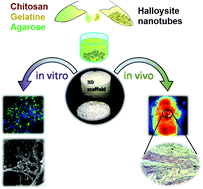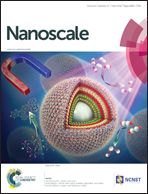Clay nanotube–biopolymer composite scaffolds for tissue engineering†
Abstract
Porous biopolymer hydrogels doped at 3–6 wt% with 50 nm diameter/0.8 μm long natural clay nanotubes were produced without any cross-linkers using the freeze-drying method. The enhancement of mechanical strength (doubled pick load), higher water uptake and thermal properties in chitosan–gelatine–agarose hydrogels doped with halloysite was demonstrated. SEM and AFM imaging has shown the even distribution of nanotubes within the scaffolds. We used enhanced dark-field microscopy to visualise the distribution of halloysite nanotubes in the implantation area. In vitro cell adhesion and proliferation on the nanocomposites occur without changes in viability and cytoskeleton formation. In vivo biocompatibility and biodegradability evaluation in rats has confirmed that the scaffolds promote the formation of novel blood vessels around the implantation sites. The scaffolds show excellent resorption within six weeks after implantation in rats. Neo-vascularization observed in newly formed connective tissue placed near the scaffold allows for the complete restoration of blood flow. These phenomena indicate that the halloysite-doped scaffolds are biocompatible as demonstrated both in vitro and in vivo. The chitosan–gelatine–agarose doped clay nanotube nanocomposite scaffolds fabricated in this work are promising candidates for tissue engineering applications.


 Please wait while we load your content...
Please wait while we load your content...